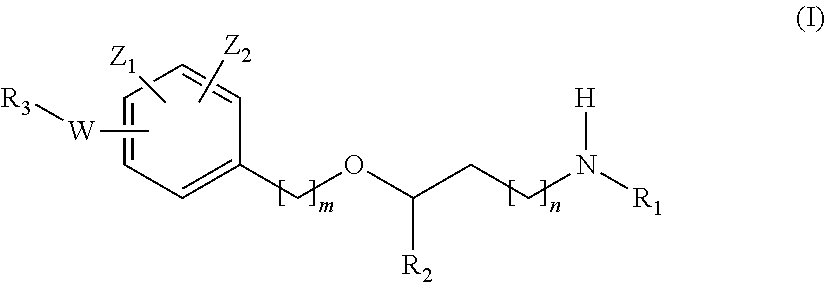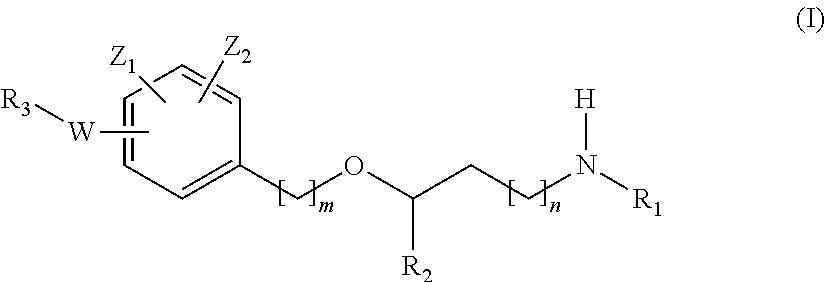Alcoxyamino derivatives for treating pain and pain related conditions
a technology of alcoxyamino derivatives and derivatives, applied in the field of alcoxyamino derivatives for treating pain and pain related conditions, can solve the problems of unrelief for patients, significant productivity loss and socio-economic burden, and less than optimal regarding the safety ratio
- Summary
- Abstract
- Description
- Claims
- Application Information
AI Technical Summary
Benefits of technology
Problems solved by technology
Method used
Image
Examples
example 1
3-(3-((1-methyl-1,2,3,5-tetrahydro-4H-benzo[e][1,4]diazepin-4-yl)methyl)phenoxy)-3-(thiophen-2-yl)propan-1-amine
[0561]
a) 3-(3-Chloro-1-(thiophen-2-yl)propoxy)benzaldehyde
[0562]To a solution of 3-chloro-1-(thiophen-2-yl)propan-1-ol (1.00 g, 5.66 mmol) in THF (10 mL) 3-hydroxybenzaldehyde (0.69 g, 5.66 mmol) and PPh3 (1.63 g, 6.23 mmol) were added. The mixture was cooled to 0° C. and DIAD (1.26 g, 6.23 mmol) was added dropwise. The reaction mixture was warmed slowly at rt and stirred for 16 h. The solvent was removed under vacuum and the residue was purified by flash chromatography, silica gel, gradient CH to 100% EtOAc to afford the title compound (700 mg, 44% yield). HPLC (Method B): Ret, 5.56 min; ESI+-MS m / z, 281.2 (M+H).
b) 4-(3-(3-Chloro-1-(thiophen-2-yl)propoxy)benzyl)-1-methyl-2,3,4,5-tetrahydro-1H-benzo[e][1,4]diazepine
[0563]To a solution of the compound prepared in step a (100 mg, 0.35 mmol) in DCE (5 mL), 1-methyl-2,3,4,5-tetrahydro-1H-benzo[e][1,4]diazepine (64 mg, 0.39 mmo...
example 2
-1,4-diazepan-1-yl)(3-(3-(methylamino)-1-(thiophen-2-yl)propoxy)phenyl)methanone
[0567]
a) Methyl 3-(3-chloro-1-(thiophen-2-yl)propoxy)benzoate
[0568]3-Chloro-1-(thiophen-2-yl)propan-1-ol was treated with methyl 3-hydroxybenzoate in the conditions used in Ex 1 step a, heating at 50° C. for 16 h to afford the title compound (51% yield). HPLC (Method B): Ret, 5.80 min; ESI−-MS m / z, 309.1 (M−H).
b) 3-(3-Chloro-1-(thiophen-2-yl)propoxy)benzoic acid
[0569]To a solution of the compound prepared in step a (1.0 g, 3.22 mmol) in MeOH (32 mL), LiOH monohydrate (810 mg, 19.31 mmol) was added and the mixture was heated at 100° C. for 1 h. The reaction mixture was cooled at rt, citric acid solution was added until pH=5 and extracted with DCM to afford the title compound, that was used in the next step without further purification (quant yield). HPLC (Method B): Ret, 5.14 min; ESI+-MS m / z, 319.0 (M+Na).
c) (3-(3-Chloro-1-(thiophen-2-yl)propoxy)phenyl)(4-methyl-1,4-diazepan-1-yl) methanone
[0570]To a sol...
example 5
3-(3-(4-methyl-1,4-diazepan-1-yl)phenoxy)-3-phenylpropan-1-amine
[0574]
a) tert-Butyl methyl(3-(3-(4-methyl-1,4-diazepan-1-yl)phenoxy)-3-phenylpropyl) carbamate
[0575]A mixture of CuI (25 mg, 0.13 mmol) and L-Proline (23 mg, 0.19 mmol) in dry DMSO (1.2 mL) was stirred at rt under Ar atmosphere for 15 min. tert-Butyl (3-(3-iodophenoxy)-3-phenylpropyl)(methyl)carbamate (322 mg, 0.69 mmol), K2CO3 (182 mg, 1.31 mmol) and 1-methyl-1,4-diazepane (75 mg, 0.65 mmol) were added and the mixture was heated at 100° C. for 42 h. The reaction mixture was cooled at rt, DCM was added, washed with water and NH4Cl sat solution. The organic layer was concentrated under vacuum and the residue was purified by flash chromatography, silica gel, gradient from Hex to 100% acetone, to afford the title compound (78 mg, 26% yield). HPLC (Method A): Ret, 6.93 min; ESI+-MS m / z, 454.3 (M+H).
b) Title Compound
[0576]To a solution of the compound prepared in step a (9 mg, 0.020 mmol) in dioxane (0.1 mL), 4 M HCl solutio...
PUM
 Login to View More
Login to View More Abstract
Description
Claims
Application Information
 Login to View More
Login to View More - R&D
- Intellectual Property
- Life Sciences
- Materials
- Tech Scout
- Unparalleled Data Quality
- Higher Quality Content
- 60% Fewer Hallucinations
Browse by: Latest US Patents, China's latest patents, Technical Efficacy Thesaurus, Application Domain, Technology Topic, Popular Technical Reports.
© 2025 PatSnap. All rights reserved.Legal|Privacy policy|Modern Slavery Act Transparency Statement|Sitemap|About US| Contact US: help@patsnap.com



